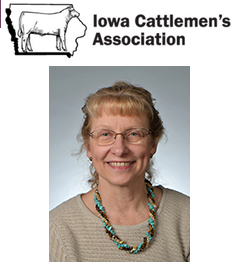Denise Schwab, interim IBC director column

June 2024
I hope June finds you all with plenty of green grass, first cutting hay baled and in the barn, and corn approaching knee high or better! It would be nice to get back to some sort of a ‘normal’ year after the last three years of drought conditions. Our Iowa Beef Center staff will be busy helping with county fairs, carcass contests, and pasture programs over the next two months. We are pretty well known for our educational programs but you may not know the extent of applied research we are involved in, so I thought I’d share a few of the feedlot related trials we’ve completed in the last few years.
Some of you are probably familiar with the ISU Feedlot Monitoring System that analyzes feedlot pen closeouts. But were you aware that Garland Dahlke also reports an annual summary by quarter of all participating pens in our ISU Animal Industry Reports? This serves as a great tool to benchmark feedlot performance and profitability with other Iowa and Midwest feedyards. The most recent report for Fall 2022 through summer 2023 included 280 pen closeouts on over 44,000 head of cattle.
Iowa State has a long history of testing new and unique feedstuffs, but did you know one of the most recent feedstuffs tested was field peas as a grain source? We don’t grow a lot of field peas in Iowa, but some producers explored that idea to break up traditional corn/soy rotations, and to use in a double-crop system. So Erika Lundy-Woolfolk and Dan Loy tested feeding field peas to finishing cattle to replace some of the corn and protein in the diet. They found that field peas could replace 30% of corn in finishing diets with minimal impact on growth performance, carcass characteristics, and meat quality. The Pea-fed steers also tended to have lower dry matter intake compared to the corn-fed steers. Thanks to funding by Corteva Agriscience for funding this project.
Another study Erika and Dan recently completed looked at the effects of market timing and implants on carcass quality. This study fed 108 steers implanted with either a moderate or high potency implant, and ultrasound scanned monthly to monitor internal and external fat deposition. Once the group reached 0.5” backfat, one-third of the cattle were marketed at that point at 68 days on feed. Another third were marketed at 96 days on feed targeting approximately 0.6” backfat with the final third marketed after 124 days on feed targeting approximately 0.7” backfat. Implants did not impact ribeye area, but the moderate implant steers continued to increase marbling when fed longer while the high potency implant steers leveled off at the second harvest date and decreased at the third date. Intake was not impacted by implant or market date, but economics favored the high potency implant steers at the second harvest date based on optimum carcass grades.
With the interest in determining feed efficiency with individual intake systems, an Iowa Beef Center mini-grant project compared cattle performance when fed with an individual feed intake system compared to a conventional bunk-fed system. Erika, Dan and Garland fed 112 yearling steers in either individual feed intake system with ad libitum feed access or conventional concrete bunks where they were fed to bunk scores of 0 for three to five days per week and ½ to 1 the rest of the week. Over the 103-day feeding period, there was no difference in body weight or growth performance, but they did see a tendency for smaller ribeyes in steers fed in the individual intake system. However, additional research is needed to determine the impact of bunk feeding system on individual steer social behavior to account for variation within a pen.
If you’d like to see more details on these projects or other research projects completed at ISU go to the Animal Industry Reports.
The IBC at Iowa State University serves as the university’s extension program to cattle producers. Our center comprises a team of faculty and staff from the College of Agriculture and Life Sciences, the College of Veterinary Medicine and Iowa State University Extension and Outreach. We work together to develop and deliver the latest in research-based information to improve the profitability and vitality of Iowa’s beef industry. If you’d like to be notified of updates on progress of research projects or programs that might be coming to your area, please subscribe to our “Growing Beef” newsletter by following the link on our website, www.iowabeefcenter.org. If you have a question, use our “Ask our Experts” link. Also, feel free to call us at 515-294-BEEF or email us at beefcenter@iastate.edu. You can follow @iowabeefcenter on Facebook, Twitter, YouTube and Instagram.
